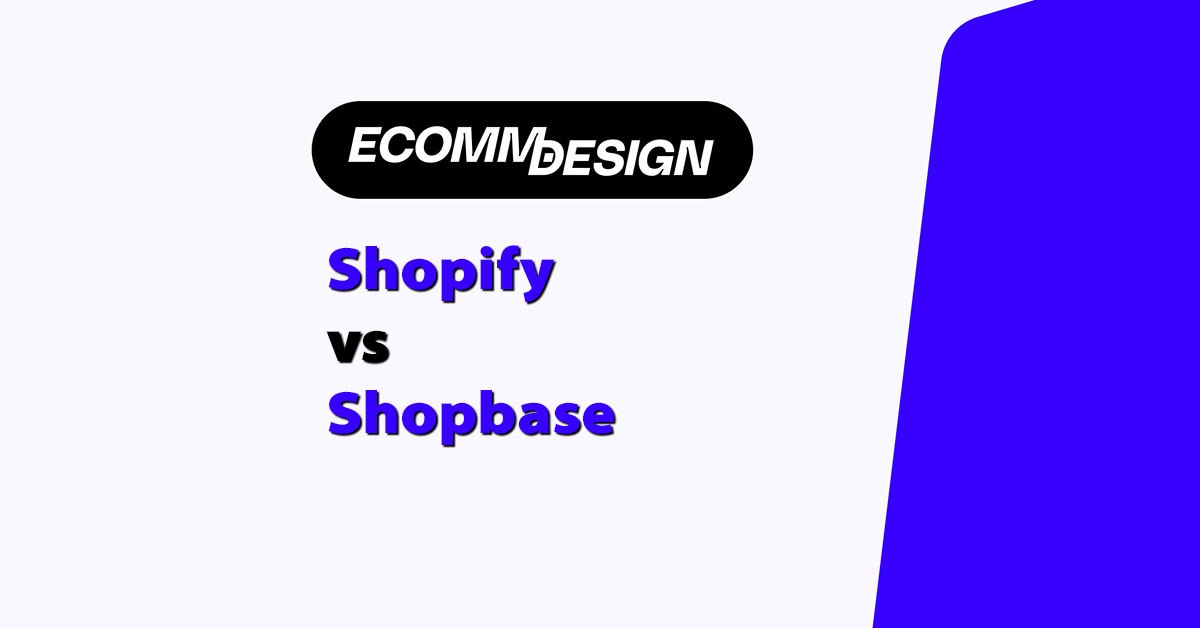
Quick answer: Shopify is the better choice overall. It’s more flexible, scalable, and easier to use with access to thousands of integrations.
ShopBase is best for beginners running lean dropshipping stores, but it falls short on SEO, apps, and design options.
I’ve built dozens of ecommerce sites on both Shopify and ShopBase — and I’ve tested everything from payment setups to page speed.
Below, I’ll break down every feature side by side so you can decide which one makes the most sense for your business.
Shopify vs ShopBase: Quick Verdict
| Platform | Best For |
|---|---|
| Shopify | Growing businesses, multiple products, SEO, marketing integrations |
| ShopBase | Dropshipping-focused sellers with small budgets |
If you’re looking for a long-term ecommerce partner that can grow with your store, Shopify wins.
But ShopBase still has value if you’re testing a single-product dropshipping idea on a tight budget.
Quick Comparison Table
| Feature | Shopify | ShopBase |
|---|---|---|
| Overall Rating | 4.8/5 | 4.1/5 |
| Starting Price | $29/month | $19/month |
| Free Trial | 3 days + 3 months for $1 | 14-day free trial |
| Transaction Fees | 2.9% + $0.30 (Shopify Payments) | No extra fees |
| Payment Options | 100+ gateways | Limited (mostly ShopBase Payments) |
| Templates | 190+ | 20+ |
| App Market | 8,000+ integrations | Small, niche selection |
| SEO Tools | Advanced (includes Semrush Booster) | Basic |
| Support | 24/7 Live Chat & Docs | Ticket/email only |
Best for Pricing: ShopBase Is Cheaper — But Lacks Value

Let’s talk money.
Shopify starts at $29/month and goes up to $299/month. ShopBase is cheaper, starting at just $19/month.
At first glance, it looks like a win for ShopBase — especially if you’re bootstrapping or testing a one-product dropshipping concept.
But here’s the catch: ShopBase doesn’t include the breadth of features Shopify offers — especially when it comes to SEO, marketing, analytics, and integrations.
That lower monthly fee often comes with trade-offs in performance, visibility, and growth tools.
Shopify also tends to rely on third-party apps to expand functionality, so your total monthly cost can rise depending on what you install.
But that’s part of its value — you’re investing in a platform that scales as your business scales.
Shopify Pricing (billed annually):
| Plan | Monthly Cost |
|---|---|
| Basic | $29 |
| Shopify | $79 |
| Advanced | $299 |
Shopify also runs a promotional offer — your first 3 months for just $1/month after a free 3-day trial. That gives you time to get set up, test features, and launch your store before committing to the full cost.
ShopBase offers a 14-day free trial, which is a bit more generous upfront. You can build your store and get to checkout without entering payment details, making it a practical option for quick MVPs or test stores.
Here’s what you get for the price:
Shopify Pros (Value for Money):
- Access to a massive app ecosystem
- Built-in SEO and marketing features
- Scalable for growing businesses
- Strong brand reputation and ongoing updates
ShopBase Pros (Budget-Friendly):
- Lower monthly cost on all plans
- No transaction fees
- Built-in features for dropshipping funnels
- Simpler setup process for lean stores
The Verdict:
ShopBase wins on upfront cost, but Shopify gives you more return on investment. Y
ou’ll pay more, but you’ll also get more growth potential — and more tools to take your store to the next level. For businesses aiming beyond the basics, Shopify is worth every extra dollar.
Best for Selling Online: Shopify Has More Power Behind It
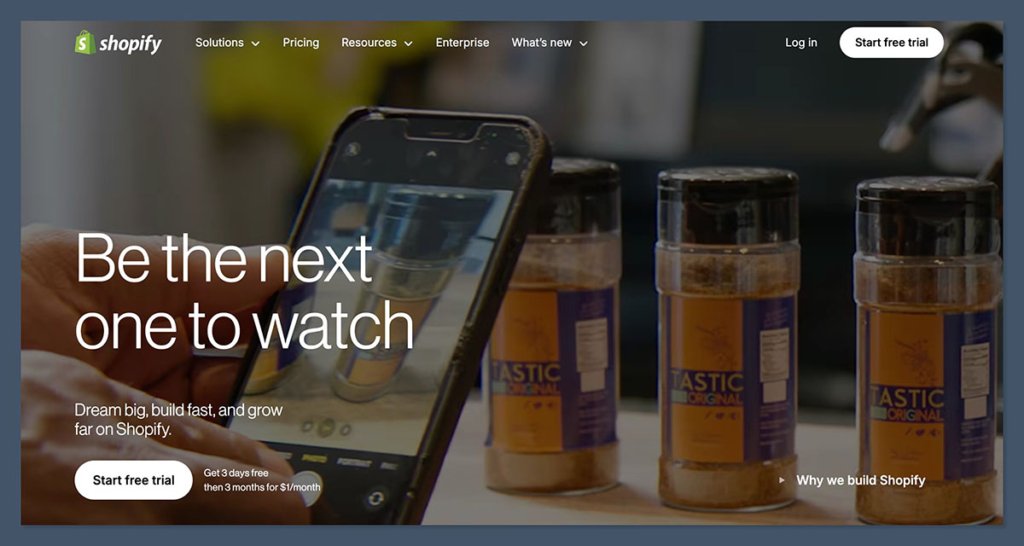
Selling is where Shopify really pulls ahead.
I’ve run multiple dropshipping and branded stores through both platforms, and Shopify consistently gave me more flexibility, tools, and stability.
As your store grows, the ability to sell across multiple channels, manage inventory in real time, and integrate with third-party services becomes non-negotiable — and Shopify delivers on all fronts.
Shopify offers:
- Shopify Magic for AI-generated product descriptions
- Omnichannel selling via Amazon, TikTok, Etsy, Facebook, Instagram, and Google
- POS system integration for retail and in-person selling
- Real-time inventory sync across all sales channels
The strength of Shopify lies in its ecosystem. It’s built for businesses that want to grow fast without switching platforms later. You can start small and add advanced features as needed, whether it’s local delivery options, customer accounts, or loyalty programs.
ShopBase focuses on:
- One-product and niche dropshipping
- Built-in tools for upsells, bundles, and cross-sells
- Checkout customization for conversions (e.g. one-click upsells, fast checkout)
- Pre-integrated with AliExpress and print-on-demand suppliers
ShopBase is streamlined for conversion-driven funnels. It’s a great fit for stores focused on a single flagship product or for entrepreneurs testing trends quickly.
The platform includes native features like quantity breaks, pre-checkout offers, and post-purchase upsells — all built-in, with no need for extra plugins.
Core selling features both platforms offer:
| Feature | Shopify | ShopBase |
|---|---|---|
| Abandoned Cart Recovery | Yes | Yes |
| Discount Codes | Yes | Yes |
| Multichannel Selling | Yes | Limited |
| Inventory Management | Advanced | Basic |
| Product Variants | Unlimited | Limited |
| Customer Profiles | Built-in | Limited |
Both platforms cover the basics like order tracking, cart recovery, and coupon creation.
But Shopify just feels more robust once you start expanding your product catalog or adding more complexity to your business.
Whether you’re selling 1 or 1,000 SKUs, Shopify gives you the backend power to handle it all without breaking down under scale.
The Verdict:
Shopify is the clear winner for established ecommerce businesses.
ShopBase is a lean machine for single-product stores, but it lacks scale.
If your business is built around one product and speed to market, ShopBase might fit. But if you want long-term selling capabilities across multiple channels, Shopify is the stronger foundation.
Payment Options: Shopify Is More Flexible
Setting up payments is a key step in launching a store, and Shopify makes this process straightforward and reliable.
It supports a wide range of payment methods, giving you and your customers more choice at checkout. That matters when you’re selling across different markets or looking to improve conversion rates.
With Shopify, you can connect your store to virtually any major payment provider, or use Shopify’s own built-in gateway to simplify the process and reduce fees.
Shopify supports:
- Over 100+ payment gateways, including:
- PayPal
- Apple Pay
- Amazon Pay
- Google Pay
- Klarna and more
- Shopify Payments, which is their native gateway
- No transaction fees when used
- Automatically adjusts to the customer’s local currency
- Multi-currency checkout, allowing customers to browse and pay in their preferred currency
The experience with Shopify Payments is seamless. Once you activate it, your store automatically supports multiple currencies, taxes, and payment methods — all managed from a single dashboard.
For U.S.-based businesses, it’s especially effective in reducing costs and chargeback risk.
ShopBase supports:
- ShopBase Payments as the main option (powered by third-party providers)
- Stripe and PayPal, but only in select countries
- Limited global options, especially outside core markets
While ShopBase covers the essentials, it lacks flexibility for international businesses. Sellers targeting multiple regions may struggle to provide localized checkout options or manage currency conversions smoothly.
Key concerns with ShopBase:
- Payout delays with ShopBase Payments
- Limited banking and currency support
- Account freezes during peak volume periods
- Reports of declined applications in higher-risk categories like supplements, digital products, and CBD
This can be a serious issue if you’re launching fast campaigns or relying on stable cash flow. Inconsistent approval times and risk scoring can lead to unexpected revenue disruptions.
Comparison Table:
| Feature | Shopify | ShopBase |
|---|---|---|
| Payment Gateways | 100+ | Limited (3-4) |
| Native Gateway | Shopify Payments | ShopBase Payments |
| Transaction Fee Waiver | Yes (with Shopify Pay) | No fees on plans |
| Multi-Currency Support | Yes | Partial |
| Payout Reliability | High | Mixed reviews |
| High-Risk Industry Support | Varies, more flexible | Often restricted |
The Verdict:
Shopify wins for flexibility, ease of use, and global options.
ShopBase might work fine if you stick to its built-in payment system and are operating in a low-risk niche, but it’s more limiting long-term.
For businesses scaling internationally or needing dependable payout infrastructure, Shopify is the safer, more scalable choice.
App Market: Shopify Dominates on Customization
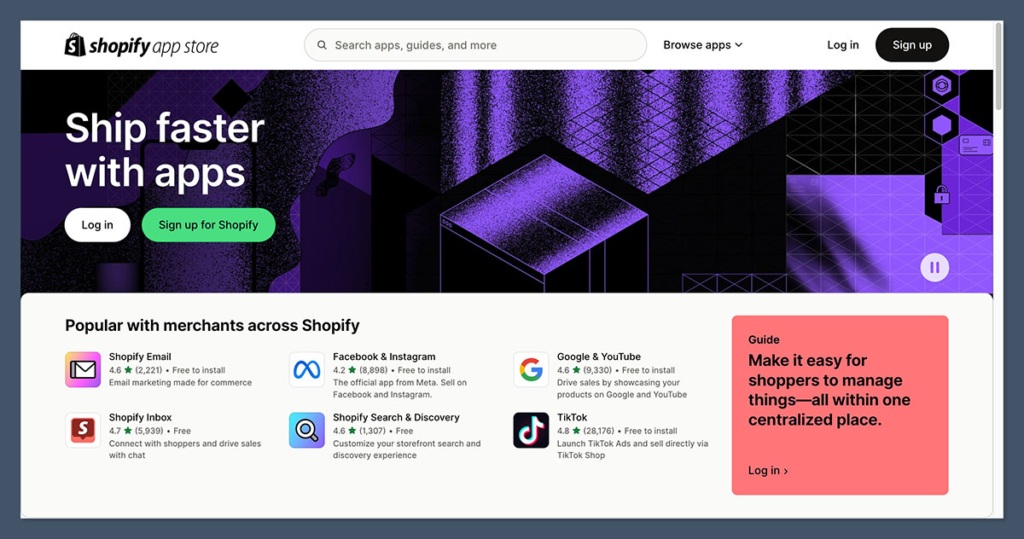
One of the main reasons I keep coming back to Shopify for client stores and personal projects is its app ecosystem.
I’ve used apps to automate email marketing, build upsell funnels, track lifetime value (LTV), run affiliate programs, and even automate logistics. With Shopify, I never hit a ceiling — there’s always an app for what I need, whether it’s free or premium.
That kind of flexibility is hard to beat. You can start with a basic setup and plug in new capabilities as you scale.
Most major ecommerce services are already integrated with Shopify, so you’re rarely building anything from scratch.
Shopify App Store:
- Over 8,000+ apps across every category imaginable:
- Email & SMS marketing (Klaviyo, Omnisend)
- CRO tools (ReConvert, Honeycomb Upsell)
- Reviews & social proof (Loox, Judge.me)
- Inventory management, accounting, shipping, and more
- Deep third-party integrations with tools like:
- Google Ads
- Facebook Ads
- QuickBooks
- Zapier
- App pricing varies:
- Free options available
- Premium apps usually range between $5 and $50/month
- Enterprise-level tools can go beyond that
Shopify’s ecosystem is especially helpful if you’re running a more advanced store.
Need a funnel builder? A loyalty program? Affiliate tracking? There are multiple apps for each, with support and documentation to help you get started.
ShopBase App Store:
- Dozens of apps designed for:
- Upsells and cross-sells
- Conversion tracking
- Fulfillment tools and order automation
- Most apps are built in-house or directly tied to ShopBase’s internal systems
- Fewer advanced or third-party options
- App selection caters to lean, conversion-driven dropshipping setups
While ShopBase does a decent job covering the essentials — especially for one-product stores or quick-funnel builds — you’ll hit limitations if you want deeper integrations or unique workflows.
App Store Comparison:
| Feature | Shopify | ShopBase |
|---|---|---|
| Number of Apps | 8,000+ | ~50+ |
| App Categories | Full ecommerce spectrum | Dropshipping-focused |
| Advanced CRM & Analytics | Yes (via integrations) | Limited |
| App Quality & Ratings | Transparent with reviews | Fewer third-party apps |
| Integration Depth | Very deep | Mostly native features |
| Automation & Scaling Support | Strong | Basic |
Shopify gives you the ability to tailor your store to your exact needs. Whether you’re focused on content marketing, customer loyalty, inventory logistics, or custom landing pages, there’s likely a pre-built solution ready to go.
This level of control is especially helpful as your store scales and your operations get more complex.
The Verdict:
Shopify gives you near-limitless control through its app ecosystem.
ShopBase’s app market is limited and built more for simple setups. It’s fine if your needs are basic, but for long-term growth, Shopify’s customization potential makes it the smarter investment.
Marketing & SEO: Shopify Has the Upper Hand
Getting traffic is half the battle in ecommerce — and turning that traffic into sales is where the real challenge begins.
Shopify wins this category by a wide margin. It’s not just about having marketing tools, but how well those tools integrate with the rest of your store.
Whether you’re aiming to rank on Google, run influencer campaigns, or grow an email list, Shopify gives you the functionality to do it all from a single platform.
Its ecosystem was clearly built with long-term growth in mind.
Shopify SEO & Marketing Features:
- SEO Tools:
- Clean URL structure
- Automatic and manual redirects
- Sitemap generation
- Meta title and description editing
- Structured data (schema) baked into most themes
- Advanced Support:
- Shopify’s Ecommerce Booster (built with Semrush)
- Provides real-time SEO recommendations and keyword audits
- Marketing Tools:
- Built-in Shopify Email for campaigns and automations
- Omnichannel selling across TikTok, Instagram, Facebook, Google Shopping
- Integration with ad platforms for dynamic product ads
- App Support:
- Dozens of high-performance SEO and marketing apps (e.g. Plug in SEO, SEO Manager, Privy)
In my experience, I’ve had Shopify stores rank on Google within just a few weeks using nothing but the default SEO settings and the Semrush Booster.
The way Shopify handles URLs, redirects, and speed optimisation makes it ideal for long-term organic traffic.
ShopBase SEO & Marketing Features:
- SEO Basics Only:
- Meta titles and descriptions
- Sitemap.xml and robots.txt generation
- Limited control over canonical tags and redirects
- Marketing Tools:
- Facebook Pixel and Google Analytics integrations
- Pre-installed scripts for conversion tracking
- Simple tools for setting up ad funnels
- Missing Features:
- No built-in email platform
- No direct support for structured data or SEO auditing
- Fewer integrations with major ad networks or influencer tools
ShopBase leans heavily on paid acquisition. It’s optimised for direct-to-checkout flows, not for building organic visibility or long-term brand equity.
I’ve had to manually fix SEO issues like improper canonical URLs or duplicate meta tags — problems that don’t usually show up on Shopify out of the box.
Comparison Table:
| Feature | Shopify | ShopBase |
|---|---|---|
| SEO Tools | Advanced | Basic |
| Built-in Email Marketing | Yes (Shopify Email) | No |
| Social Selling Channels | Full integration | Limited |
| Structured Data Support | Yes | No |
| Semrush Integration | Yes | No |
| Influencer & Ad Integrations | Available via apps | Basic Pixel/GA support |
| SEO Apps Available | 100+ | Very limited |
For content-driven ecommerce brands, Shopify’s SEO capabilities make a huge difference.
If you’re blogging, building backlinks, or optimising for product discovery on Google, it has everything you need without having to duct-tape external tools together.
The Verdict:
Shopify is far more advanced if you’re playing the long game.
ShopBase is fine for short-term funnels or paid ads, but not great for organic growth. If SEO matters to your business model — and it should — Shopify is the stronger foundation.
Ease of Use: Both Are Simple, But Shopify Feels More Polished
Ease of use can make or break your experience — especially if you’re setting up your first store.
The good news is that both Shopify and ShopBase are beginner-friendly. You don’t need coding experience or design skills to get a store live on either platform.
But after using both extensively, I’ve found Shopify delivers a noticeably smoother experience. From sign-up to launch, Shopify is more intuitive, more responsive, and more supportive.
The interface feels modern and refined, and each step in the setup process flows naturally into the next.
Shopify Pros:
- Step-by-step setup guide walks you through every essential step
- Helpful setup wizards ask relevant questions to tailor your store experience
- Visual editor is clean, well-structured, and supports drag-and-drop elements via Shopify’s Online Store 2.0
- App recommendations and tips are built into the dashboard as you go
- Great onboarding even if you’re brand new to ecommerce
One of the things I appreciate about Shopify is how little friction there is. When you sign up, it immediately gives you prompts based on your business type and where you plan to sell — online, in-person, or both. The dashboard is clearly labeled, and there’s a dedicated “launch checklist” that keeps you moving forward.
ShopBase Pros:
- Clean, minimal dashboard with a strong focus on getting your product live fast
- Easy product import, especially from AliExpress or using their print-on-demand tools
- Quick funnel setup ideal for dropshipping stores focused on conversion
If your goal is to test a product quickly and get it in front of an audience via ads, ShopBase makes that process fast and straightforward. You can set up product pages, checkout flows, and upsell sequences with very little friction.
That said, ShopBase’s simplicity comes at the cost of flexibility.
When I’ve needed to customize templates or edit certain backend settings, I often found myself looking for workarounds or needing developer support — things that Shopify handles natively.
User Experience Comparison:
| Feature | Shopify | ShopBase |
|---|---|---|
| Onboarding Guidance | Extensive & helpful | Basic walkthrough |
| Dashboard Navigation | Clean & intuitive | Clean but limited |
| Visual Editing | Section-based + OS 2.0 | Basic layout control |
| Learning Curve | Very beginner-friendly | Easy for dropshipping only |
| Product Importing | Manual or via apps | Built-in for AliExpress |
| Setup Speed | Fast | Very fast for 1-product |
While ShopBase gets you live quickly, it doesn’t offer as much in terms of design flexibility or user interface customization.
The visual editor can feel rigid, especially if you’re trying to build a brand with more personality or complex layout needs.
The Verdict:
Shopify feels more thought-out. ShopBase works, but lacks polish in the backend and store editor.
If you’re building something long-term and want the flexibility to adjust as you grow, Shopify offers a better experience all around.
Templates and Store Design: Shopify Is Cleaner and More Customizable
Design is one of the first things your customers will notice — and it’s where many ecommerce stores either convert visitors or lose them.
A clean, professional-looking storefront builds trust. It shows customers that you’re running a serious business. This is one area where Shopify clearly stands out.
With Shopify, you get access to a large library of modern, responsive themes — all optimised for usability, speed, and mobile performance.
Whether you’re selling handmade goods, subscription boxes, or digital products, there’s a theme built for your niche.
Shopify offers:
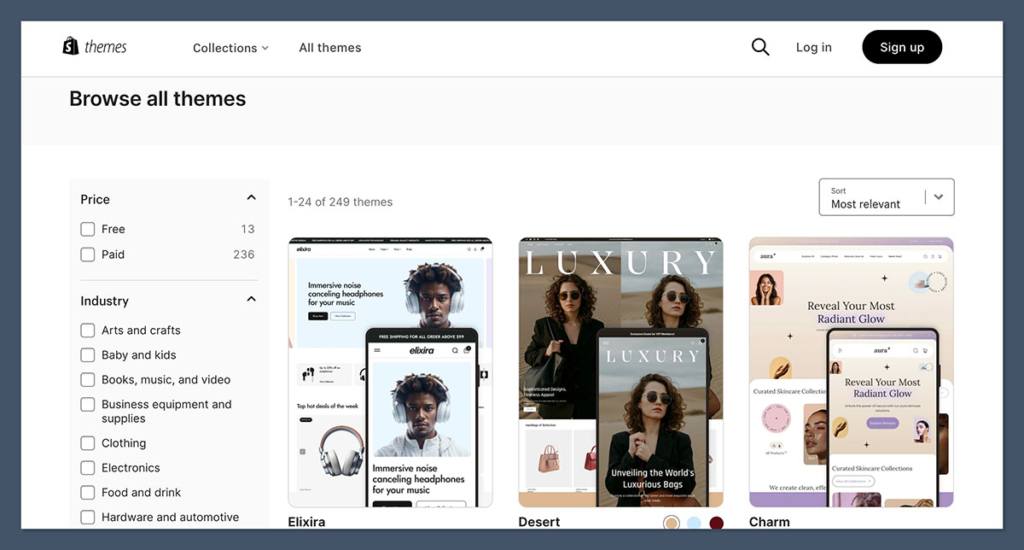
- 13 free themes designed with clean layouts and fast loading speeds
- 180+ paid themes ranging from $140 to $400 (one-time fee)
- Drag-and-drop customization using Online Store 2.0
- Themes for every industry, including fashion, food, home goods, electronics, and more
- Mobile-optimized and designed to convert on smaller screens
Shopify’s theme editor lets you customise colours, fonts, sections, images, and layout — without touching code. Most themes also come with multiple styles, so you can switch up the look without changing the theme entirely. It’s a huge benefit if you want to launch fast but still maintain a branded, high-end look.
ShopBase offers:
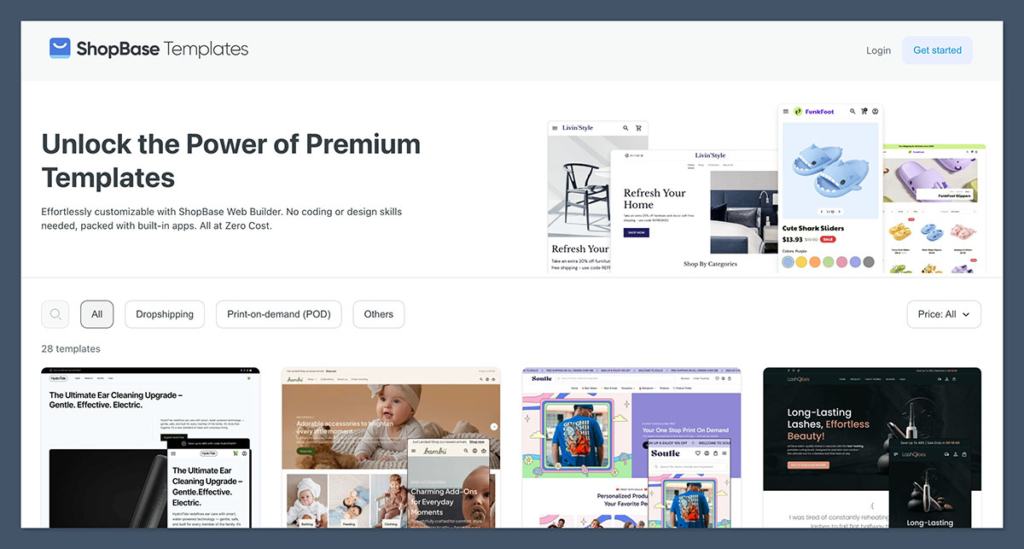
- 20+ templates, mostly free and designed for dropshipping
- Product-focused layouts optimised for fast funnels and one-product stores
- Simple customization, but limited compared to Shopify
- No drag-and-drop functionality — changes are more form-based and rigid
ShopBase themes do what they need to do: present the product, drive urgency, and push the user to checkout. They’re clean, conversion-driven, and lightweight.
But they’re not ideal for brands looking to stand out visually or create a memorable experience.
Theme Comparison:
| Feature | Shopify | ShopBase |
|---|---|---|
| Number of Templates | 190+ | ~20 |
| Free Templates | 13 | Most are free |
| Customization Flexibility | High (drag-and-drop editor) | Low (limited controls) |
| Mobile Optimization | Yes, all themes | Yes, but fewer options |
| Industry Variety | Wide range | Dropshipping only |
| Visual Appeal | Modern and professional | Basic and utilitarian |
If you’re building a brand and want that polished, premium look, Shopify’s design options will give you the tools to get there.
It’s also much easier to tweak small things — like button size, font weight, or layout spacing — without relying on developers or workarounds.
On the other hand, if your only goal is to launch a simple, direct-response funnel, ShopBase templates will get the job done — but don’t expect much beyond the basics.
The Verdict:
Shopify gives you modern, customizable themes that look great on all devices.
ShopBase themes are serviceable but feel outdated. For a brand that wants visual credibility and design flexibility, Shopify is the clear choice.
Support & Documentation: Shopify Is More Reliable
Things will break — that’s just ecommerce. Whether it’s a payment gateway glitch, an app integration issue, or a product not syncing, problems are going to happen.
When they do, fast and reliable support can make the difference between a minor delay and lost revenue.
This is where Shopify really proves its worth. I’ve relied on their support team during product launches, Black Friday traffic surges, and even random API issues — and I’ve consistently received help quickly.
Shopify Support:
- 24/7 live chat support, with AI agents for simple questions and human agents for technical issues
- Extensive Help Center, filled with step-by-step guides, tutorials, and troubleshooting articles
- Active community forums where you can get input from other store owners
- Priority support on higher-tier plans (Shopify Plus)
- Social media support via Twitter/X and Facebook for public or urgent queries
One of the key benefits is that Shopify’s live chat is available 24/7, no matter your timezone. I’ve had checkout bugs resolved in real-time during high-traffic sales windows — without needing to open a ticket and wait. That’s critical when every minute of downtime means lost conversions.
ShopBase Support:
- Email-based ticket system only
- No live chat, phone, or social media support channels
- Help center documentation covers the basics but lacks depth
- Slower response times, especially on weekends or during sales periods
When I ran into a billing issue on ShopBase, I submitted a ticket and waited more than 36 hours to hear back.
For a simple subscription billing fix, that delay felt avoidable — and it would’ve been a bigger problem if my store had gone offline.
While ShopBase does try to provide straightforward support for common setup questions, its resources aren’t built for fast problem-solving when things go wrong.
You’re stuck waiting in a queue, with limited visibility on when you’ll hear back.
Support Comparison:
| Feature | Shopify | ShopBase |
|---|---|---|
| Live Chat Support | Yes (24/7) | No |
| Email Support | Yes | Yes (only) |
| Phone Support | Shopify Plus only | No |
| Knowledge Base | Extensive and up-to-date | Basic and limited |
| Community Forum | Yes | No |
| Support Response Speed | Minutes (chat) | 24–48 hours (email) |
| Weekend/Holiday Coverage | Yes | Inconsistent |
If you’re running a growing store, support isn’t just a “nice-to-have” — it’s a must. Whether it’s an integration issue or a customer service emergency, having access to help at any time keeps your store running smoothly.
The Verdict:
Shopify wins here by a mile. Fast, live support is crucial if your store goes down or payments fail.
ShopBase can work if you’re running a low-volume test store, but for anything serious or time-sensitive, Shopify’s support structure is in another league.
Final Verdict: Shopify Wins for Most Ecommerce Businesses
After testing both platforms across pricing, selling tools, SEO, apps, payments, support, and design — Shopify is clearly the better option for most ecommerce businesses.
It’s more scalable, more reliable, and more feature-rich across every stage of growth.
ShopBase has its place.
It’s a lightweight platform built with one goal in mind: helping you launch fast. For certain niches — like single-product dropshipping or temporary product testing — it does the job.
But once you need more than just a landing page and a checkout button, its limitations become hard to ignore.
Use Shopify if you:
- Want to scale to multiple products, categories, and sales channels
- Need strong SEO tools to drive organic traffic long-term
- Care about branding, design flexibility, and building a polished customer experience
- Plan to leverage apps and automations to grow faster
- Expect dependable support and infrastructure that won’t collapse under traffic spikes
Use ShopBase if you:
- Are testing a low-budget dropshipping product
- Need to launch a minimum viable store in days, not weeks
- Don’t rely on organic traffic or advanced marketing
- Are happy with a basic funnel and simple backend
Platform Summary:
| Use Case | Shopify | ShopBase |
|---|---|---|
| Long-term Business Growth | Excellent | Not Ideal |
| Branding & Design Control | Very Strong | Basic |
| SEO & Organic Growth | Strong Tools | Limited |
| App Ecosystem | 8,000+ Apps | Minimal |
| Best for Dropshipping MVPs | Good | Excellent |
| Reliable Payment & Support Systems | Yes | Not Consistent |
Shopify doesn’t just support your business — it grows with you. Whether you’re adding team members, launching to new regions, or building a brand that competes globally, the platform gives you the tools and infrastructure to keep going.
ShopBase can serve as a springboard. But once you gain traction or need more control, you’ll likely find yourself migrating to something stronger — and in most cases, that ends up being Shopify anyway.
For serious ecommerce businesses, Shopify is more than worth the cost. It grows with you, gives you more control, and has a proven ecosystem behind it.
If you’re building for the long term, it’s the smarter investment.






